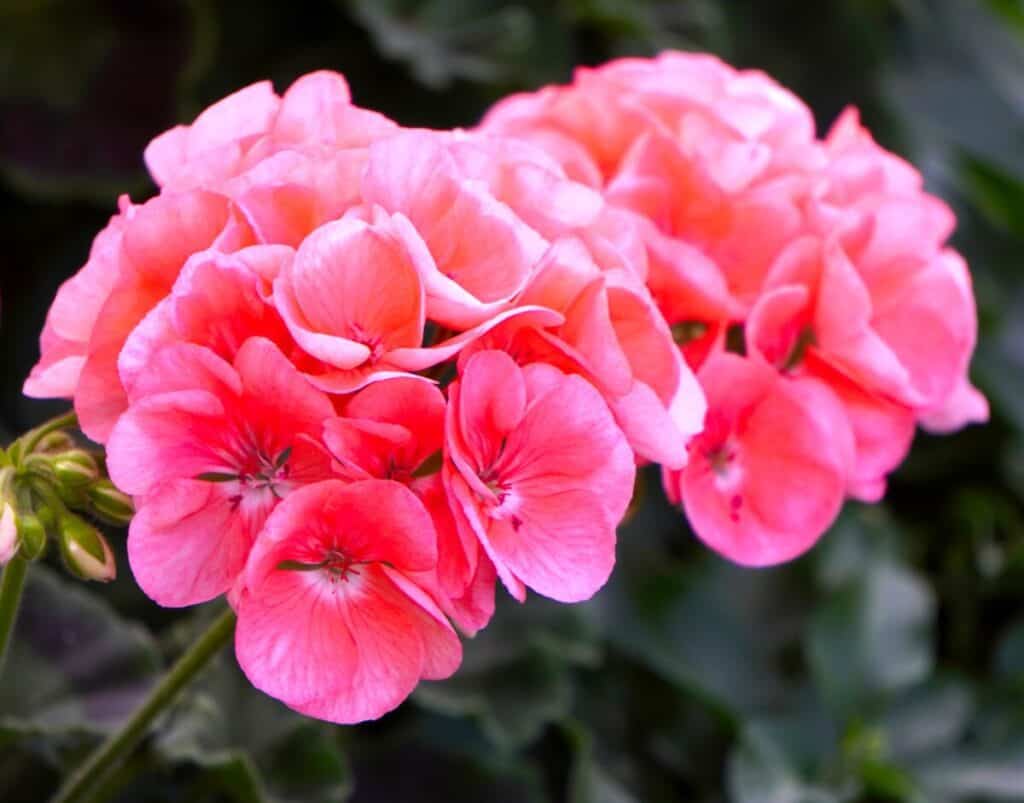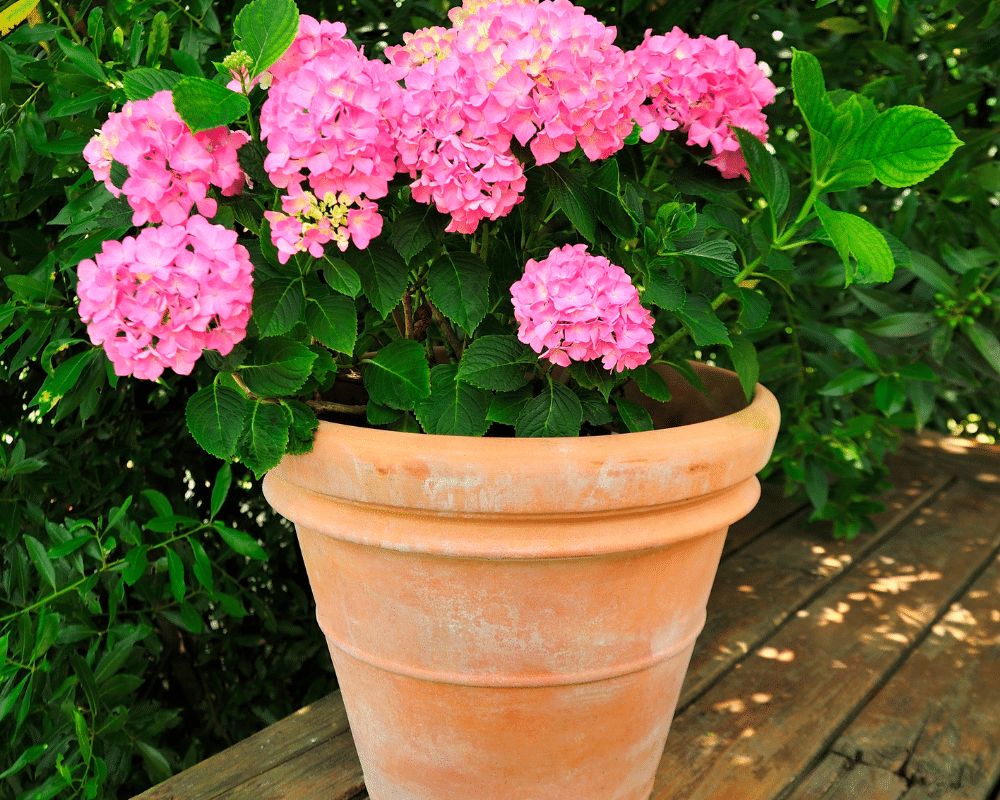A Mainstay of the Garden
Flamboyant Geraniums are a mainstay of the garden and a core element of container planting. Here is how to select the best geraniums for your garden. The plant is a flowering American classic, although it’s not American. But, of course, it’s not even a Geranium! It’s a Pelargonium. In addition, its continuous popularity means that there are numerous varieties. Each one is suited to a certain purpose, and if you know that purpose, life will be much easier in the garden!

We love the colors we find in the plants and the scents they bring us. They make us think of growing up with family gardens and of that trip to Europe and charming places with geranium-filled window boxes. Perhaps we remember the geraniums we saw as kids along the 4th of July parade in our old hometown. Now we want some of that vibrancy and feeling on our balcony, patio, or garden.
How To Tell The Difference Geraniums and Geraniums
This discussion is about the window box plant, with the big full array of flowers. So we call it Geranium, but it’s in the genus Pelargonium. The perennial Geranium, in the family Geranium, is a plant with much smaller, cup-shaped flowers. Got that? Because in horticulture, you really can’t tell the players without a scorecard!
How To Get Started in Selecting Your Best Geranium

Here They Are-Geranium Varieties and Features
| VARIETY | FEATURES | COLORS/DESCRIPTION | GROWING NOTES |
| Zonal Geraniums | Most popular/ dark zonal markings on leaf | White, Red, Pink, Burgundy, Bicolor | Tough, like dry conditions, problems in hot, humid conditions. |
| Ivy Geraniums | Trailing format | Look like zonal, sold in flats, with a high amount of blooms | Primarily used in containers, windowboxes, hanging baskets |
| Seed Geranium | Look like zonal, sold in flats, a high amount of blooms | , compact plants, and single flowers in various colors. | Smaller, compact, treat as bedding plants. |
| Scented Geraniums | Rich fragrance, with many scents and leaf shapes. i.e., lemon, lime, mint | come in a wide range of sizes. Have small pink or white flowers | Bright lights, dry between waterings |
| Interspecific Hybrid | These are zonal geraniums crossed with ivy geraniums. | look for Caliopes and Caliente | |
| Variegated Geraniums | Color in leaves and blossoms | Look for Ice Queen, Happy Thought, Mrs. Henry Cox, Mrs. Pollock, Vancouver Centennial | |
| Regal/Martha Washington | Brilliant flowers, ruffled blossom, | 12-18″T, 132-24″W | Not good in the heat, prefer cooler and more wet environments—fertile, well-drained soil. |
Some Varieties of Zonal Geraniums
Cultivars are manufactured varieties of a plant. They are designed to offer us plants with features we desire in our gardens. These recommendations come from the San Diego Geranium Society.
- Appleblossom Rosebud-Pink and white bicolor blossoms in a pom-pom shape.
- Black Velvet Rose-The flowers are bright rose-pink, and the leaves are dark chocolate brown. (Sounds like candy)
- Calliope Dark Red-Has double blooms in dark red. It is a cross between a zonal geranium and an ivy leaf.
- Divas Orange Ice-The flower is white and soft orange; the society says it looks like a creamsicle.
Some Varieties of Ivy Geraniums
- Crocodile-White veins in the foliage.
- Royal Amethyst-Heat resistant plant with lilac flowers.
- Temperance Butterfly-Bright pink with lots of petals.
- Mahogany-Flowers are red and white bicolor.
Some Varieties of Seed Geraniums
- Maverick geraniums-Prolific, with large 5-6″ flowerheads, the best variety for smaller containers, heat tolerant. Colors-Scarlet, white, violet, orange, apple-blossom, quicksilver, scarlet picotee, star, pink, coral.
Interspecific Caliope and Caliente Geranium
- Caliope-Long bloom period, versatile. Look for Dark Red, Lavender Rose, and Crimson Flame (bicolor). They are sun, heat, and drought-tolerant. Not successful in wet locations.
- Caliente-Developed for high heat conditions, colors are bright; look for Hot Coral, Orange, and Lavender. In southern regions give, even these afternoon shade.
If you are interested in growing more geraniums, here is a research piece from the University of Florida. If your interest includes using annual bedding plants other than Geraniums, this post may be helpful. To see their whole article go here.
Variegated Geraniums

These are zonal geraniums with outstanding foliage. You grow these because you love the unique foliage features. In fact many fanciers cut the rather strident blooms as soon as they appear. The foliage is brilliant and often, in the US, hard to find. You also grow these if you are the owner of a true Victorian garden. This information comes from the website “A Garden For The House.” There is a lot more detail to be had in the garden.
Available colors include green, gray, silver, gold, white, yellow, cream, and red.
Regal-Martha Washington
These are hybrids and are created to show off the shape and many colors of this plant. They are large, 12-18′ high, and 12-24″ wide. The Martha Washington plants are cool-temperature beauties, preferring night temperatures of 50-60 degrees. Please do not allow them a high nitrogen fertilizer.
What Is Our Geranium?

We call it a Geranium and have done so since the early 1700s. Linnaeus categorized them as Geraniums in 1753. Botanists changed their minds, and it was changed to Pelargonium. But people were accustomed to the name, and it stuck!
What’s the difference? They do look alike. Each has five petals. In the true perennial Geranium, the petals are all alike. In our Geranium/Pelargonium, the top two petals are not the same as the bottom three.
Our annual Geranium has been wildly popular since the mid-1800s. By the 19th century, they were considered bourgeoise. People like William Morris and Oscar Wilde made fun of them. Nobody cared. They are still popular.
How Do We Grow Them?
Choosing the Best Plant

Look for a dense, solid plant with multiple branches, green leaves, and buds, at least one of which will show the color. Check under the leaves for signs of pests or discoloration. Look also for signs of healthy white roots. Check the label for the variety you have chosen.
This plant should be able to bloom all summer, come indoors to a sunny window for the winter, and acclimate back to outside next year. In my climate (Zone 10 in South Florida.), they are challenged by our heat and humidity, but we move them to part shade locations, and they usually last several years for us and produce new plants via cuttings.
Planting
Plant them in well-drained soil in a place receiving 6-8 hours of sun. In planters, use a well-drained potting mix.
Soil
Geraniums prefer slightly acidic soil of pH 5.8-6.5, rich but well-drained. In containers, use a general-purpose potting mix.
Fertilizer and Water
During the growing season, fertilize outdoor geraniums with a dry fertilizer -10-10-10, applied at 2 lbs per 100 square ft. Water, well after this. Geraniums will not bloom if over-fertilized.
Here are the symptoms of fertilizer problems. Lack of nitrogen; the plant has slow growth is stunted and has yellow leaves. Lack of phosphorous; the plant has very dark foliage and is stunted. In potassium deficiency leaf margins die, and the plant exhibits weak stems and stalks. The best advice is to read the labels carefully.
For watering, it is helpful to stress the plant slightly by waiting for a day or two between watering. This will encourage an increase in blooms.
Other Care
For the best appearance, deadhead any spent blossoms at the bottom of the stem—trim branches to encourage bushiness. Prune and trim off any unhealthy stems. A healthy stem will feel firm to the touch. If it is soft, it is ready to be removed.
Pests and Diseases
Pests include these:
Aphids: Remove damaged foliage, and wash with water; if that is insufficient, use insecticidal soap. Let the soap dry for a few hours, and wash the leaves with water. Repeat it every 7-10 days as long as it is needed.
Cabbage Looper: two-inch green caterpillars with white stripes on the back. They are voracious eaters. Controls are to handpick them from the plant, always do a good fall clean up, and attract beneficial insects.
Diseases include these:
Rust: is a fungus and transmitted by wind and rain and can be treated by a fungicide. Watering at the root rather than from above can reduce the chance of fungus.
Leaf Spot: is a bacteria that comes from warm, wet, and overcrowding.
Botrytis: this comes from cool, moist conditions with too much moisture. The damage appears as lesions on the leaves and is treated with a fungicide.
Root Rot: a fungus that starts in the soil as a result of lack of drainage. The damage appears as soft brown roots. The best prevention is superior drainage.
To Overwinter Geraniums
Before the first frost of the fall, lift the plants. Then cut the stems back to a length of about 6-8″. Plant the trimmed plant into a small pot using standard potting soil. Keep the plant in a shady spot for about one week, then keep it in a sunny spot for the winter. During the dormant period, water the plants only when dry and do so sparingly also do not fertilize during their dormant period.
Winter Vacation In A Paper Bag?
Remove the plant from its pot or garden space. Shake off most of the soil. Trim away any of the blossoms and any dead or wilted plant material and let the bare-rooted plant rest for about 48 hours. At this point, it is dry, and you place it upside down in a brown paper bag and store it in a dry place. You can try it?
I have never done this, but I remember friends of my mother swearing by this method. (Well, as much as they swore!). I saw it recently displayed in a video, which brought it to mind.
Propagating Your Geraniums
Geraniums grow well from cuttings. Start with a clean small pot, sterile potting mix, a sharp small knife, and alcohol. Cut stem pieces of about 4-6 inches with limited leaf material. Clean the knife with alcohol and plant in moist soil. You should see roots form in about five weeks.
Summary
The many ways in which we can use geraniums (Pelargoniums) make them a mainstay of the garden. Handsome to look at, simple to deal with, and propagate, they offer us beautiful blooms, unique foliage as well and a fruity-spicy scent. In addition, we can use them in the garden, in a great variety of containers, and inside the house as well.
Resources You Can Use
‘How to Enjoy Vibrant Annuals in the Dog Days of Summer.’
‘How to Grow Dramatic Agapanthus in Containers and Pots.’
‘Water the Garden Not the Plants.’https://rootsandmaps.com/how-to-grow-dramatic-agapanthus-in-containers-and-pots/
